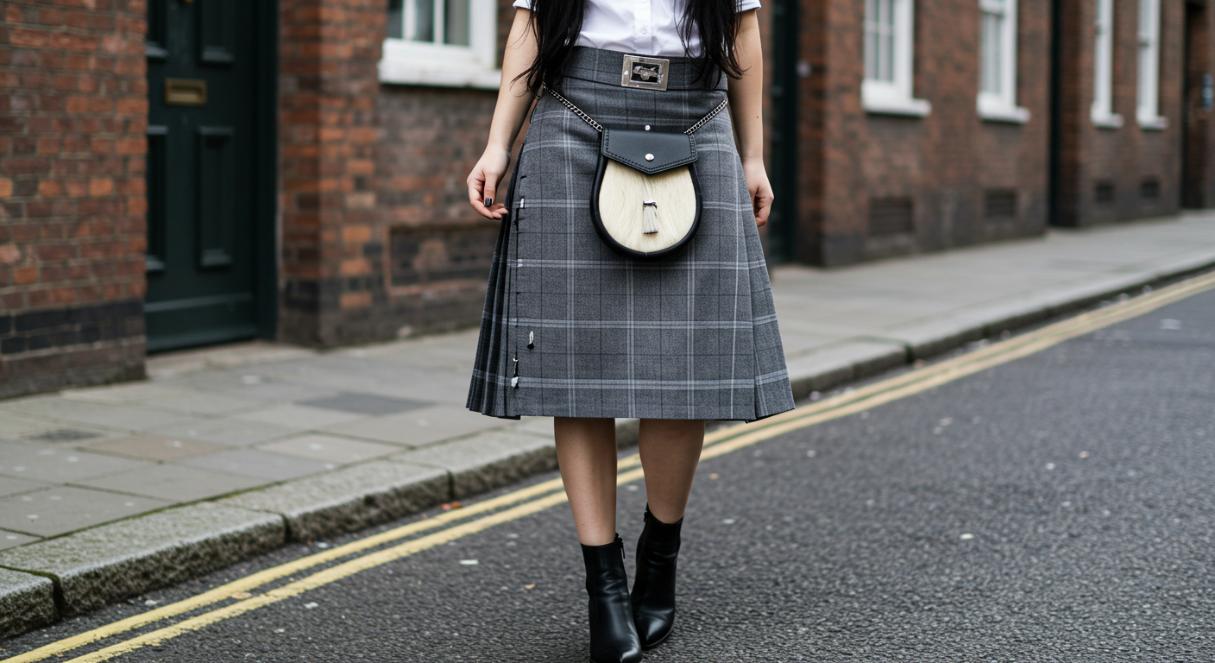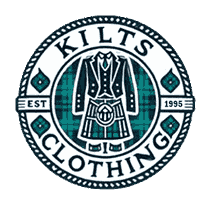The Revival of Formal Kilts in Contemporary Fashion: A Look at Recent Trends

Once viewed as traditional garments of the Scottish Highlands, Kilts have made an unexpected yet exciting return to contemporary fashion. Once reserved mainly for formal events, military regalia, or Highland ceremonies, formal kilts are now making their mark on the modern fashion landscape. This blog explores the journey of the formal kilt's revival, examining the trends, influences, and creative adaptations that have brought this iconic garment back into the limelight.
1. A Historical Look: The Formal Kilt's Journey in Fashion
The Formal kilt has long been a symbol of Scottish heritage, traditionally worn by Highland clans for hundreds of years. Initially, the kilt served a practical purpose as a versatile garment designed for the rugged terrain of the Scottish Highlands. Over time, the kilt evolved into a formal dress, particularly within military regiments, and later as a key part of Scottish ceremonial attire.
However, by the mid-20th century, the formal kilt's presence in mainstream fashion had declined significantly. Outside of ceremonial occasions like weddings and special Highland gatherings, the kilt was seen less and less in everyday fashion. In the 1960s and 1980s, however, signs of revival were sparked by the growing popularity of Scottish heritage and fashion trends. Today, kilts are experiencing another resurgence, thanks to cultural shifts and the evolving fashion industry.
2. Factors Driving the Resurgence of Formal Kilts
A combination of cultural movements, changing attitudes toward heritage fashion, and shifts in consumer preferences have contributed to the kilt's recent revival. Here are some of the key factors driving this trend:
Cultural Movements and Heritage Fashion
Over the last decade, there has been a growing interest in "heritage fashion," with more people looking to connect with their roots through the clothing they wear. This resurgence in traditional and handcrafted clothing has paved the way for the revival of the kilt, an iconic piece of Scottish heritage. The appeal lies in the garment's timeless nature and ability to evoke a sense of identity and pride.
Celebrity Endorsements and Pop Culture
Pop culture has also played a significant role in bringing the kilt back into the fashion spotlight. Celebrities like Billy Porter and Kanye West and musicians like the members of Run DMC have been spotted wearing kilts at significant events, challenging conventional notions of gender and formal wear. These high-profile moments have made the kilt a statement of individuality, breaking away from its traditional, regional roots and positioning it as a heritage and modern style symbol.
Sustainability and Vintage Appeal
The growing sustainable fashion trend is another factor contributing to the formal kilt's revival. Consumers are increasingly opting for durable and timeless pieces rather than fast fashion. Often made from high-quality wool or tweed, Kilts are well-suited to this demand for lasting, high-quality clothing. Additionally, the vintage appeal of kilts—especially vintage tartan designs—has attracted fashion-forward individuals looking for unique, one-of-a-kind pieces with rich cultural significance.
3. The Influence of Tartan and Highland Heritage on Modern Kilts
One of the most striking features of the formal kilt is its tartan pattern, which serves as both a fashion statement and a symbol of heritage. The tartan, associated with various Scottish clans, is central to the design of the kilt, providing a sense of identity for those wearing it.
Today, tartan patterns have been reimagined to suit modern tastes, with designers incorporating fresh color palettes, bolder designs, and different fabric choices. Some newer designs blend traditional tartan with contemporary textiles like cotton blends and wool alternatives, allowing the garment to maintain its traditional charm while adapting to modern needs.
Highland heritage has also entered the fashion world as brands seek to incorporate Scottish symbols and motifs into their clothing. Modern kilts remain deeply connected to their cultural roots, from plaid-inspired patterns to incorporating Scottish symbols in accessories. The resurgence of these patterns has allowed the formal kilt to become a way for wearers to embrace tradition and modernity.
4. Modern Adaptations: From Classic to Contemporary Designs
With its complete pleats and heavy woolen fabric, the classic kilt remains a timeless choice for formal occasions like weddings or cultural events. However, contemporary designers have breathed new life into the kilt by adapting it for the modern wardrobe.
Slim-Fit Kilts
In response to changing tastes, many designers have introduced slim-fit kilts tailored to hug the body more closely, providing a sleek and streamlined look. These contemporary designs are more versatile and can be worn in formal and semi-formal settings, giving the kilt a more fashionable edge.
Hybrid Kilts
Another innovation is the formal kilt for sale, which combines the traditional kilt with elements of other garments, such as trousers, skirts, or even dresses. Hybrid kilts offer a fresh take on the formal garment, allowing wearers to enjoy the uniqueness of the kilt while staying on-trend with modern fashion silhouettes. These hybrid designs can be seen in high-fashion collections and streetwear, making the kilt more accessible and wearable.
Minimalist Kilts
Minimalism has also influenced the modern kilt, with some designers creating simplified versions of the traditional garment. These kilts forgo excessive embellishments like sporrans, pins, and other accessories, offering a clean, contemporary look that focuses on the lines and cuts of the garment. This pared-down aesthetic makes the kilt more adaptable for day-to-day wear and formal occasions where a subtler approach is desired.
5. Kilts in High Fashion: Designers Bringing Kilts into the Spotlight
The revival of the kilt is not just limited to casual wear; it has also made its way onto high fashion runways. Designers have embraced the kilt as both a fashion statement and a symbol of heritage. The iconic kilt has appeared in collections from top designers like Vivienne Westwood, Alexander McQueen, and Jean Paul Gaultier, who have all added their twist to the traditional design.
At Fashion Weeks worldwide, kilts are featured in innovative collections, often combined with other cultural garments or styled in bold new ways. These high-fashion renditions of the kilt have played a crucial role in pushing the boundaries of traditional clothing, making the garment a more versatile and global fashion icon.
6. Kilts on the Red Carpet: The Celebrity Influence
Kilts have become a symbol of individuality and style, especially on the red carpet. Celebrities like the late Alexander McQueen's muse, Sarah Jessica Parker, and musicians such as Pharrell Williams have embraced kilts as a powerful fashion statement at significant events. Their appearances have sparked discussions about the kilt's role in challenging traditional gender norms and exploring new forms of expression in formal wear.
The celebrity influence has helped the kilt reclaim its place in the fashion world and positioned it as a statement piece that transcends cultural boundaries. Celebrities wearing kilts have helped the garment become more than just a Scottish tradition—it's now a symbol of global fashion innovation.
7. Kilts in Everyday Fashion: From Street Style to Formal Wear
While kilts were traditionally reserved for special occasions, they have recently entered everyday fashion. Contemporary streetwear has embraced kilt-inspired garments, such as kilt skirts and hybrid kilt trousers, making the garment more accessible for people who want to add a touch of the traditional to their daily wardrobe. These kilt-inspired pieces can be paired with modern clothing, blending the classic with the cutting-edge.
The modern kilt is increasingly becoming a go-to option for formal events for those who want to stand out. The contemporary formal kilt has become an alternative to more conventional formalwear, whether worn at weddings, gala events, or cultural festivals.
8. The Role of Social Media and Online Communities in Kilt Revival
In the age of social media, trends spread faster than ever, and the revival of the formal kilt has benefitted from platforms like Instagram, TikTok, and Pinterest. These platforms allow fashion enthusiasts and influencers to showcase their kilt styles, sharing tips and ideas with their followers. Online communities dedicated to kilt culture and fashion also play a significant role in normalizing the kilt as a fashion-forward garment.
9. The Future of Formal Kilts in Fashion
The future of formal kilts looks bright. With a growing interest in sustainable, heritage-inspired fashion, kilts are poised to continue their resurgence in mainstream and niche fashion. As more designers explore the creative potential of the kilt, its presence in high fashion and everyday wear will only grow.
10. Conclusion: The Enduring Appeal of the Formal Kilt
The formal kilt, with its rich cultural history and evolving design, is a testament to the power of fashion to bridge tradition and modernity. As contemporary designers continue to innovate and reinterpret the garment, the kilt will likely remain a staple of high fashion and everyday wear. Whether worn to embrace heritage or make a bold style statement, the kilt's revival signals its enduring relevance in fashion.


